According to the bio on Catharine Clark Gallery's website, "Travis Somerville was born in 1963 in Atlanta, GA. Growing up in towns throughout the southern United States and along the eastern sea board, he briefly studied at Maryland Institute College of Art, Baltimore, MD, finally settling in San Francisco where he attended the San Francisco Art Institute, CA. His large scale oil paintings on paper mounted to canvas incorporate collage and present images of political and cultural icons associated with the history of the south. His work explores the complexities of racism and serves as a point of departure for discussion about US oppression and colonial attitudes abroad."
There were collage paintings, installations, and graphic art on display. The most engaging one was the installation piece:
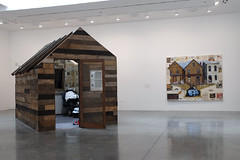
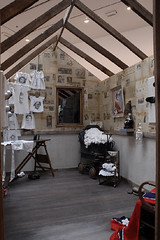
Inside this little cottage, I saw the "replicas" of old furniture, and fascinating vintage newspaper articles on the walls - with news like President Kennedy's funeral procession, the shooting of his suspected assassin, etc. Many white cottons shirts and dresses were on laundry lines and an ironing board. Black figures made of fabric -- rag dolls -- occupied places the dwellers would have been sitting. A window opened to the dark world outside, where a small cross was burning. A radio was on, playing the sound of the burning cross. It was a rather aesthetically intriguing, or even pleasing sight. Yet unholy.
Another large installation was a roof of a submerged house. Instead of human beings, vintage photographs took their place atop the roof. The lower part of these photographs were colored in blue, representing the rising water. It evoked the memories of the sad events in New Orleans during the aftermath of Hurricane Katrina.
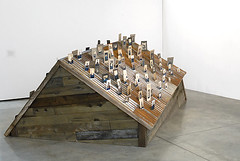
Two installations were in a similar vein. One was simpler and consisted of only two water fountains - a regular fountain for white people and a bucket for "colored." Inside the bucket I saw only dried red soil. Above the fountain and bucket was the vintage sign below:
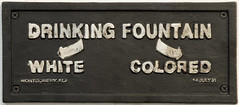
The more complicated installation had many more water fountains. In the middle was a modern day water fountain which dispenses cold water, painted in Dixie flag pattern - for white people. Three smaller fountains on each side were designated for Muslim, Black, Asian, Pacific Islander, Native American, etc. Water calmly oozed out of the seven sprouts. Inside the basin, derogatory symbols corresponded to the labels above. This installation was quite provocative.
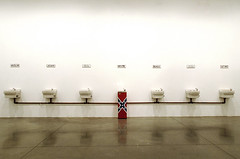
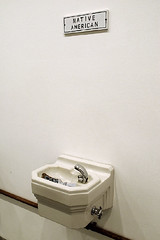
His collages represented collapsed trees, houses, a bust of Martin Luther King, and dreams. The graphic piece was a collage of Kennedy and Obama - roughly upper left and lower half for one, the other parts for the other. I couldn't tell if it was optimistic or pessimistic. Perhaps that was what it meant to be.
This exhibition reminded me another one I saw recently at Lawrence Hall of Science at University of California, Berkeley - RACE: Are We So Different?

The premises of this exhibit was summarized on the official website as below:
It’s a simple truth: People are different.
Throughout history, these differences have been a source of community strength and personal identity. They have also been the basis for discrimination and oppression. This exhibit provides an opportunity to understand race from a biological, cultural, and historical perspective through engaging, hands-on science experiences; real artifacts; and videos that present people’s unique stories.
The exhibit explores key issues that relate to race including:The Race exhibit clarified many mis-conceptions and posed many important questions. What I felt somewhat missing was an exploration of relationships amongst minority groups in the U.S. and the directions and steps one might take to build a socially just society. However, the opening of the dialogue was an important step in the right direction.Skin color does not equal race.
Use a microscope to view your skin close up. Scan it and watch as your image appears on screen with skin images from dozens of other people.
Voices do not identify race.
Use a large touch-screen monitor to try to match a voice you hear to a photo you see.
We all have common ancestors.
Use a wheel to control an animated interactive map of how humans spread out from Africa to populate the world.
The Travis Somerville show ends on April 3, 2010 and the Race exhibit ends on May 2, 2010. I highly recommend both.





No comments:
Post a Comment